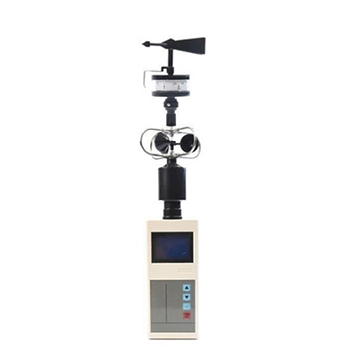Anemometers, as the name suggests, are instruments for measuring air velocity. The anemometer has a wide range of applications and brings us a lot of convenience in measuring wind speed. So do you know how to use an anemometer? Now we will tell you how to use the anemometer, hoping to help you.
Preparation before use
Set the calibration switch to the off position.
Insert the measuring rod plug into the socket, place the measuring rod vertically upwards, and press the screw plug tightly to seal the probe. Set the correction switch to the full-scale position, and slowly adjust the full-scale adjustment knob so that the pointer of the ammeter points to the full-scale position.
After unexpected power failure, the data saved in the host will not be lost.
The probes are consistent, and the host can access different types of sensors through the hub.
Before operation, you should first check whether the relevant parts of the anemometer are in good condition, and whether the fan inside can rotate normally. Turn on the power and check the display on the screen. If the battery symbol appears on the screen, the power supply needs to be replaced at this time. The use of the anemometer also has certain requirements on the environment, and the device cannot be used in a high temperature or very humid environment.
Steps for usage
- Adjust the meter pointer to zero before use.
- Put the correction switch in the off position.
- Place the measuring rod vertically upward, the probe is sealed, and the plug of the measuring rod is powered on.
- The meter pointer is adjusted to the full-scale position through the "full-scale adjustment" button.
- The correction switch is at the zero position, and the ammeter pointer is adjusted to the zero position through the two buttons of fine adjustment and coarse adjustment.
- Adjust the screw plug to expose the probe of the measuring rod. The red point of the probe faces the wind direction. According to the data of the electric meter, compare the calibration curve to find out the wind speed.
- The measurement takes about ten minutes, and the measurement is repeated three to four times to ensure the accuracy of the data.
- Finally, turn off the switch and cut off the power.
Working principle
An anemometer for wind direction is a speed measuring instrument that converts a flow velocity signal into an electrical signal, and can also measure fluid temperature or density. The principle is that a thin metal wire heated by electricity (called dedicated line) is placed in the airflow. The heat dissipation of the dedicated line in the airflow is related to the flow rate, and the heat dissipation will cause the temperature of the dedicated line to change and cause the resistance to change, and the flow rate signal will change into an electrical signal.
It has two working modes:
Constant flow. The current through the special line remains constant. When the temperature changes, the resistance of the special line changes, so the voltage at both ends changes, and the flow rate is measured.
Constant temperature. The temperature of the dedicated line remains constant, such as 150°C, and the flow rate can be measured according to the required applied current. The constant temperature type is more widely used than the constant flow type. The length of the special line is generally in the range of 0.5-2 mm, the diameter is in the range of 1-10 microns, and the material is platinum, tungsten or platinum-rhodium alloy. If a very thin (thickness less than 0.1 micron) metal film is used instead of a metal wire. It is a hot film anemometer, which has a similar function to a hot wire, but it is mostly used to measure the flow rate of a liquid.
In addition to the ordinary single-line type, the special line can also be a combined two-line or three-line type to measure the velocity components in each direction. The electrical signal output from the special line is input into the computer after being amplified, compensated and digitized, which can improve the measurement accuracy, automatically complete the data post-processing process, and expand the speed measurement function. For example, the measurement of instantaneous value and time-average value, combined velocity and partial velocity, degree of turbulence and other turbulent parameters can be completed at the same time. Compared with the Pitot tube, the special-line anemometer has the advantages of small probe volume, small interference to the flow field, fast response, and can measure unsteady flow velocity; can measure very low velocity (such as low as 0.3 m/s).
Type of anemometers
According to the principle: thermal anemometer, ultrasonic anemometer, impeller anemometer, three-cup anemometer (such as sisco anemometer 3-cup type 0~30 m/s), windmill anemometer, pitot tube anemometer, etc.
Divided by probe shape: directional anemometer, non-directional anemometer.
According to the test range and test parameters: medium and high temperature anemometer, micro anemometer, multi-parameter environmental tester, etc.
Application fields of anemometer products
It can measure wind speed and air temperature. This anemometer can be used in indoor air quality/industrial health environment, environmental testing in pipelines, performance debugging of HVAC equipment and other fields.
With the help of an adjustment switch, the anemometer is based on the cold impact airflow taking away the heat on the heating element to keep the temperature constant, then the adjustment current is proportional to the flow rate. When using thermal probes in turbulent flow, airflow from all directions impinges on the thermal element simultaneously, which can affect the accuracy of the measurement results.
When measuring in turbulent flow, the indication value of the flow rate sensor of the thermal anemometer is often higher than that of the rotary probe. The above phenomena can be observed during pipeline measurements even at low speeds.
Therefore, the anemometer measurement process should be carried out on the straight part of the pipeline. The starting point of the straight line should be at least 10×D (D=pipe diameter in CM) before the measuring point; the end point should be at least 4×D behind the measuring point.

